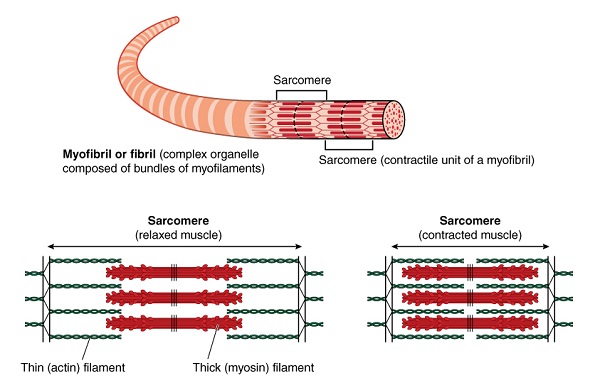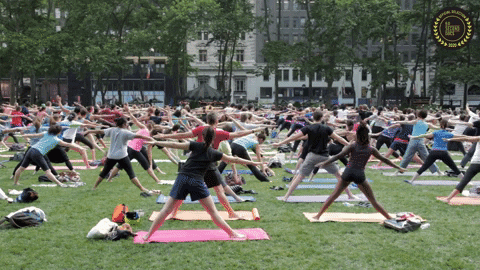For as long as I can remember, I’ve been told stretching is good for the body. It’s something we should all do as it increases flexibility. And from high school to university, many of us have been taught flexibility is considered one of the five components of fitness. A quick search confirms this and results in 100s of articles stressing the benefits of stretching. It’s also something I do on most days. But what is it actually doing, and is it good for you?
Flexibility is assessed by the range of motion around a joint. Some joints, such as the shoulder, are meant to move in different planes (front and back, side and up). In contrast, the elbow moves within one plane. The extremes of a joint’s range of motion are limited by how the bones form the joint. For example, while you can straighten your elbow, boney processes on the bones stop it from hyperextending. However, for many joints it’s really your muscles and tendons that limit it from achieving its full possible range. Think of trying to do the splits. The joints allow for it, but not many of us can do it. When the muscles limit a joint’s range of motion, we may refer to them as being tight, or short.
It’s believed having tight muscles, and low flexibility, reduces muscular strength, limiting one’s performance, increasing chances of injury and preventing speedy recovery from workouts. If this happens, it can affect one’s ability to perform daily activities. And the definition of fitness is being able to do daily activities without fatigue. Therefore, it goes, that being flexible is needed to be fit.

How does stretching work?
Each muscle is made up of individual fibres (myofibrils) that span the entire length of the muscle. Small muscles used to move the eye, have less than 100 fibres, while larger muscles can have up to 1000. Within each fibre is a series of overlapping strands, or sarcomeres. When the muscle contracts, these strands are pulled together and the overlap increases. When the muscle relaxes, the overlap decreases, and the muscle lengthens.
There’s no doubt that regular stretching can increase your flexibility. But it’s not believed to do so by actually lengthening the muscle. In fact, muscles likely have a limited length, which can’t be altered. This is a good thing, because if a muscle was too long, the strands may no longer overlap and affect its ability to contract. Think of an elastic stretched too far. As a result, muscles don’t like to be stretched.
When you stretch a muscle, you may notice some initial pain or discomfort. This is because you’ve triggered the stretch reflex. This is a response in which the stretched muscle sends out a pain signal and tries to contract. The muscle does this as a self-protection mechanism. And if the muscle is stretched too much, too fast, the pain will be greater in order to get you to stop. However, after a few seconds of controlled stretching, this reflex goes away. It’s after this point you notice being able to move further into the stretch. But the muscle doesn’t really change it’s length. What happens is your nervous system is able to tolerate the stretch without signalling any pain, giving the impression the muscle has gotten longer.

Popular Ways to Stretch
There are a number of different ways to stretch. Static stretching is the most common method. It consists of gently stretching the muscle to it’s limit (point of initial discomfort) and holding it there. One might hold the stretch anywhere from 20 to 90 seconds, or more. Passive stretching is similar, except an external force is used to move the limb or body to create the stretch. This force can be gravity (such as hanging a leg off a bed) or having a second person hold you in position.
Ballistic and dynamic stretching are two types that incorporate movement into the stretch. Ballistic is effectively jerking your body or limb to force it beyond it’s range of motion. An example is standing upright and then bouncing up and down to touch your toes. However, because of the potential injury and uncontrolled movements, ballistic stretching isn’t recommended.
Dynamic stretching involves moving a joint through it’s full range of motion without stopping. For example, swinging one leg back and forth like a pendulum, or doing arm circles. Anytime you get up and roll your shoulders or rotate your hips, you’re doing dynamic stretching. This type of stretching has become popular with sports teams as part of an active warm-up.
PNF (proprioceptive neuromuscular facilitation) stretching is a combination of passive stretching alternated with muscle contraction against a force (usually a partner). The muscle is passively stretch to its limit, then the muscle is contract against a resistance (i.e. your partner) while not moving. The contraction is held for a few seconds before relaxing, followed by another passive stretch. This may be repeated 2-3 times per muscle. This this form of stretching takes the most amount of time, it does appear to result in greater flexibility than static stretching.

Does stretching help?
Stretching has been touted as a way to improve performance, reduce injury and quicken recovery. As a result, it’s quite common to see people stretching before going for a run or playing tennis, etc. While stretching certainly improves flexibility, it’s been questioned as to whether increasing flexibility is of any benefit.
Static stretching before exercise has been shown to weaken maximal strength by 8%. And the longer a stretch is held (>45 sec), the more impact it can have on reducing strength and power. It’s believed stretching alters the ability of the nervous system to activate the muscle and may lead to joint instability. But these studies are applicable more for activities of pure strength and power. Whether static stretching can help with your running (or similar aerobic activity) is unclear.
A review of randomized studies also found stretching had no effect on injury prevention. At the same time, it didn’t appear that stretching increased injury either. In contrast, in the same review, both strength training and balance-focused exercises reduced the chance of exercise-related injuries.
Stretching also doesn’t seem to have an affect on recovery. If you’ve just started exercising, tried a new activity or had a harder than usual workout, your might find your muscles are sore the day after. This is called delayed onset muscle soreness. And it’s common for people to stretch after their workout in the hopes of speeding recovery and reduce muscle soreness (I commonly do my stretching then). However, stretching after exercise doesn’t appear to reduce muscle soreness or speed up recovery.
Most of these studies focused on static stretching or didn’t specify the type of stretching. So it’s hard to know if one type of stretching is better than another. However, dynamic stretching may not have the same negative effects as static stretching and may be beneficial as part of a warm-up.

When Stretching May be Needed
That doesn’t mean stretching doesn’t have it’s place. For example, people focused on activities that require joints to move through their whole range of motion, such as dancing, gymnastics or even hockey goalies, regular stretching is a must to maintain that range. And if you’re recovering from an injury which has limited your natural flexibility, stretching can be important to your recovery.
Stretching may also have a calming effect and relieve stress. It’s something usually done with singular focus. It can also improve blood flow to the muscle and may reduce blood pressure. And, if you’re like me, you may just enjoy it.
In the end, the flexibility of your muscles will depend on how active you are on a daily basis. For a person who sits at a desk all day, the hamstring muscles will be less flexible because they’re not used to moving. In contrast, someone who is active throughout the day is likely to be more flexible. If you do choose to stretch, add dynamic stretching to your warm-up and leave static stretching to later on in the day (or not at all).
If you like this post, don’t forget to subscribe to my blog at the bottom of the page.
Enjoy listening to podcasts? Check out my show How to Health. A podcast about you and your health.


Leave a Reply